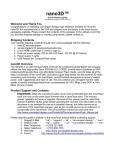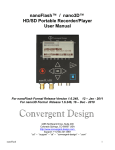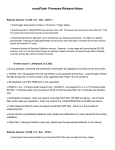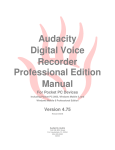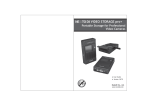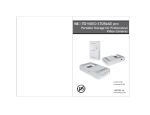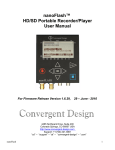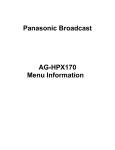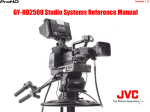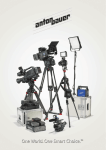Download NanoFlash FAQ`s
Transcript
NanoFlash FAQ’s Most Frequently Asked Questions 1. When will the nanoFlash ship? The target date for initial nanoFlash shipments is late May 2009. ar y 2. Can I get a brief description of nanoFlash? nanoFlash is a portable HD/SD recorder/player designed to mount on a camcorder. It is also suited for use in a studio environment. The nanoFlash is designed to record higher quality images than the camera itself, using the camera’s HD-SDI/HDMI output. nanoFlash accepts an incoming HD/SD-SDI video signal, with embedded audio and timecode or an HDMI video and audio signal. The nanoFlash records the video/audio as MPEG2 at user selected bit-rates. This allows the user to choose, for every shoot, an appropriate image quality, file size, and maximum available length of recording. The data is then stored on CompactFlash cards, in either native Quicktime or native MXF file formats. in The nanoFlash uses 90% of the same code and components as the field-proven and award-winning Flash XDR. nanoFlash customers will enjoy the benefits of all many hours debugging and testing the Flash XDR. im nanoFlash can also be upgraded to become a full ASI encoder and decoder, an additional charge option. ASI is a streaming format used for live-news broadcast and DTV digital signage. Pr el 3. What are the applications for nanoFlash? a. To upgrade the video quality of your existing camera b. Tapeless Workflow c. Proxy Recorder d. Digital Signage e. Presentations, Trade Shows, Theme Parks, Museums, Feature Production Review f. Helicopters, Race Cars, Airplanes, Jets, etc. g. Portable HD/SD recorder for switcher output h. POV camera recorder i. Video Assist j. Review of Footage on any HDMI HDTV or HD-SDI or HDMI Monitor k. ASI Encode / Decode 4. Will nanoFlash work with my camera? If your camera has an HD/SD-SDI or HDMI output with a compatible format, then the answer is yes. Some popular cameras include: a. Sony PMW-EX1, PMW-EX3, V1U, F900, F923, XDCAM HD b. Canon XL-H1s, G1, HV20, HV30 c. Iconix HR-1 d. Hitachi HV-HD30, DK-H32 e. Ikegami HDL-2 f. JVC GY-HD250, GY-HD251, GY-HD200UB g. Panasonic HPX170, HPX500, GP-US932 3/6/2009 Convergent Design, Inc. Page 1 of 21 NanoFlash FAQ’s h. Toshiba IK-HR1S i. Thomson Viper ar y 5. Will nanoFlash improve the image quality of my existing camera? Three major components largely determine the ultimate video quality from your camera: the lens, the CCD/CMOS sensor, and the built-in recorder. Some cameras do offer interchangeable lenses, so you may have the option to upgrade over the standard issue. The CCD/CMOS sensor is fixed on all cameras and cannot be modified. However, all HD-SDI and HDMI cameras allow users to upgrade the recording subsystem, which can yield significant improvement at reasonable costs. It’s really quite simple, but let’s first discuss the problem with your built-in recorder. el im in Your camera’s recording subsystem has two major components: the CODEC and the storage device. The CODEC compresses the video from about 1000 Mbps (uncompressed HD) to a more manageable 20 to 140 Mbps. The storage device is typically a tape, optical disk, or possibly a memory card. Compressed video, along with audio and timecode, is stored on these media for playback or transfer to a NLE. Pr The CODEC and storage medium are both significant in determining your video quality. In general, the higher the compressed bit-rate, the better the video quality. However, most storage media severely restrict the possible data-rates. Mini-DV tape (used in HDV cameras), for example, has a fixed read/write bandwidth about 25 Mbps; SDHC memory cards are limited to about 45 Mbps. So, the ultimate data-rate from the CODEC must be restricted to match the performance of the storage medium. The level of sophistication and implementation of the CODEC play a major role as well. I-Frame only CODECs, in general, require two to three times the bit-rate to equal the quality of the more sophisticated Long-GOP CODECs. (100 Mbps I-Frame is roughly equivalent to 35 Mbps Long-GOP in overall quality). Most CODECs, (HDV, DVCProHD, XDCAM EX, and even HDCAM) also reduce the potential quality through color-sample decimation (4:2:2 → 4:2:0 or 3:1:1) and/or by horizontally sub-sampling (1920 → 1440 or 1920 → 1280). 3/6/2009 Convergent Design, Inc. Page 2 of 21 NanoFlash FAQ’s The Solution: nanoFlash - High-Bit Rate, Full-Raster, 4:2:2 The nanoFlash overcomes these quality-robbing restrictions in your camera. You connect to the HD/SD-SDI or HDMI camera output (in live mode) to send “never-compressed” video directly from the CCD/CMOS sensor to the high-quality CODEC and then to the high-speed digital storage (CompactFlash cards) in the nanoFlash. ar y Since nanoFlash records on CompactFlash solid-state memory, (as opposed to tape, optical disk or SDHC cards) the bit-rate can be substantially increased over your built-in recorder. Data-rates up to and including 100 Mbps are easily achievable on low-cost (133X 32GB = US $90) cards, while rates over 100 Mbps are possible on higher-cost cards (233X 32GB = US $205). nanoFlash features a sophisticated high-quality Sony MPEG2 CODEC with data-rates up to 100 Mbps in Long-GOP mode (I,P,B Frames), and up to 160Mbps in I-Frame-only mode. The CODEC compresses the video without reducing the color sampling (full 4:2:2) and without sub-sampling the horizontal data (full 1920). im in So what does full-raster (1920), full-color (4:2:2), high-bit rate (160 Mbps), compression produce? Well, in our tests, as well as independent tests, the results are clear: images that are visually indistinguishable from the uncompressed HD-SDI / HDMI images directly out of your camera! So, nanoFlash can vastly improve on the weakest link in the quality chain: your camera’s built-in recorder. el 6. Can you explain the usage in Digital Signage / Presentations? nanoFlash offers three distinct operating modes for digital signage / presentations a. Multi-Channel, Multi-Display using the optional ASI to Consumer Display b. Single-Channel, Multi-Display using HDMI to Consumer Display c. Single-Channel, Multi-Display using HD/SD-SDI to Professional Display Pr Multi-Channel, Multi-Display Using ASI nanoFlash can be ordered with optional ASI encoding capability. ASI streams compressed MPEG2 video and audio over an SDI transport. The ASI output from nanoFlash can be directly connected to a QAM modulator (from Blonder Tongue or RL Drake, for example) and output to a standard DTV channel. Then using an RF amp and distribution network, this signal can be combined with multiple channels and fed over a standard RF coax to one or more consumer DTV HD displays (via the F connector). (All displays now have built-in RF demodulators and MPEG2 decoders, so no extra hardware is required). A very cost-effective multiple-channel multiple-display digital signage application can be assembled using one or more nanoFlash units with ASI connected to QAM modulators / up-converters. Single-Channel, Multi-Display Using HDMI nanoFlash can be directly connected to virtually any consumer HD display via HDMI. Multiple displays can be driven using a HDMI distribution amp. This topology can be very cost-effective assuming short cable runs. 3/6/2009 Convergent Design, Inc. Page 3 of 21 NanoFlash FAQ’s Single-Channel, Multi-Display Using HD/SD-SDI nanoFlash also features an HD/SD-SDI output, which can be connected to an SDI distribution amp to simultaneously drive multiple professional monitors. Cables runs up to 150 meters (per link) are possible using HD-SDI connections. 7. How can nanoFlash be used in video assist applications? Currently, users can play back any file using the control panel. You can also move from file to file very quickly using the right and left arrows. ar y We are now developing remote RS-485 control which will allow the playback of any selected clip from one or more nanoFlash units, via a simple menu selection on the remote PC/handheld. Metadata can also be input via this simple connection. Video/Audio I/O in 8. What video input and output connections are supported on nanoFlash? nanoFlash uniquely includes both HD/SD-SDI In and Out as well as HDMI In and out connections. The HD/SD-SDI connections are made via a standard BNC connector, while the HDMI I/O uses the new type C mini-HDMI connector (to save space). im 9. Which video input formats are supported? 1080i60/59.94/50, 1080psf30/29.97/25/24/23.98, 1080p30/29.97/25/24/23.98 720p60/59.94/50, 486i/576i 10. What about 720p29.97/25/23.98 support? This is planned in a near-term release. Technically, nanoFlash can support these formats; however, we are researching the NLE compatibility with our 4:2:2 CODEC. el 11. Can nanoFlash be upgraded to support 4:4:4 sampling? No, this is outside the capabilities of the hardware design. Pr 12. Will 1080p60/59.94 or 1080p50 be possible in a future release? Support of these formats requires 3G HD-SDI, which is not possible with the current hardware. 13. Can nanoFlash auto-detect the incoming HD/SD-SDI / HDMI stream? Yes, auto-detect is the default setting. 14. Can nanoFlash be used as an HD/SD-SDI → HDMI or HDMI → HD/SD-SDI converter? Yes, this capability is inherent in the design. 15. Does nanoFlash perform cross / down conversions? No, nanoFlash does not perform 1080i ↔ 720p or HD ↔ SD type conversions. Our design goals limited the power and size of the box. Also, cross / down conversion was deemed unnecessary, as most video sources already provide this functionality. 3/6/2009 Convergent Design, Inc. Page 4 of 21 NanoFlash FAQ’s 16. Can nanoFlash remove the pull-down (inverse telecine) and record in 1080p24/ 23.98? This will be provided in a future firmware release. Assuming the 1080i60/59.94 HD-SDI input was created from a 24/23.98p frame rate, then nanoFlash will remove the extra frames and record at the 24/23.98 frame rate. 17. Can nanoFlash remove the pull-down on the HDMI input? Yes, pull-down removal will be possible on the HDMI input as well as the HD-SDI input. 19. Can nanoFlash support 2K formats? No, unfortunately this is not possible. ar y 18. Can nanoFlash also remove the extra frames on 720p25/24 over 60 formats (VariCam) and record at 25/24 fps? Yes, this capability will also be included after 720p29.97/25/23.98 support is finished. in 20. Can nanoFlash flip the image from the Red Rock Micro, P+S Technik, or other 35 mm adapters? In a future release, a menu option will be provided to flip the frame to accommodate many 35mm lens adapters. The HD-SDI monitor output will show the corrected image, but delayed two frames. im 21. Does nanoFlash have a genlock input? No; not in the traditional sense. When recording, you need to genlock the cameras. Since nanoFlash locks to the incoming HD/SD-SDI source, it will also be genlocked automatically. During playback, multiple nanoFlashes can be genlocked via a master HDSDI distribution amp. Pr el 22. I have two (or more) cameras; can I synchronize the capture on a frame-by-frame basis (for 3-D, for example)? Yes, if all video sources are frame synchronized using a blackburst generator to each camera, then all the video captures to each nanoFlash box will be synchronized. If the various cameras are not frame synchronized then the captures will be accurate to +/- 1 frame. 23. Does nanoFlash have a pre-record buffer? In a future release, the nanoFlash will allow for a pre-record buffer of approximately 8 seconds. 24. Can I record continuously, overwriting the oldest footage? Given the low-cost of the Compact Flash media and the ability (in a future release) to hot-swap the media, overwriting the oldest footage is deemed unnecessary. 25. How can I monitor the video? nanoFlash has both HD/SD-SDI and HDMI outputs which are active during record (loopthru) as well as playback. 3/6/2009 Convergent Design, Inc. Page 5 of 21 NanoFlash FAQ’s 26. Is a color bar generator included? This is planned for a future release. Our plans are to automatically output a SMPTE color bar pattern if no incoming HD-SDI signal is detected (while the box is operating in record mode). Additionally, we plan a menu option to output a color bar pattern through the HDSDI outputs. 27. What are the audio input choices? Zero, two, four or eight channels of audio embedded in the HD-SDI/HDMI stream. The audio is stored in PCM (uncompressed) 24-bit, 48-kHz format. ar y 28. How can I monitor the audio? Audio levels are displayed on the LCD panel (2-Channels, -60 to 0 dB). nanoFlash does not have analog audio out, but the headphone output from your camera may be used. 29. Since nanoFlash does not have analog audio, how can I embed the audio into the HD/SD-SDI stream? There are a number of audio embedders available, we suggest the AJA HD10AMA. Compact Flash im in 30. Can the audio be delayed / advanced relative to the video? In a future release, the audio will be adjustable by up to +/- 4 frames relative to the video. The granularity of the adjustment has not yet been determined. el 31. What is Compact Flash? Compact Flash (CF) is an industry standard memory card widely used in digital cameras. CF utilizes solid-state NAND Flash memory, and is extremely rugged (no moving parts), consumes very little power, is very reliable, low-cost and is available with a lifetime warranty from some manufacturers. Pr 32. Does Compact Flash have sufficient read/write bandwidth for HD video? Yes, Compact Flash has more than sufficient (read/write) bandwidth and storage capacity for very high-quality MPEG2 HD Video without stripping across multiple cards. Master quality HD video requires 100 to 160 Mbps bandwidth, a feat easily achievable on many Compact Flash cards. SDHC cards, on the other hand, are too limited (45 Mbps read/write) for high-quality video/audio. 33. Why Compact Flash (instead of Hard-Disk Drive or other solid-state media)? a. Solid-state media, no moving parts b. Low-power (about 1/10 of hard disk-drive) c. Very reliable (all solid-state); 100K write cycles, 10 year data retention d. Easily removable, 10K insertion cycles. e. Low-cost (32GB = US $90); about 1/10 to 1/20 the price of other professional solidstate media. f. High read/write bandwidth (up to 300 Mbps read/write speeds) SDHC is limited to about 45 Mbps, which is too low for high-quality video. 3/6/2009 Convergent Design, Inc. Page 6 of 21 NanoFlash FAQ’s g. Widely available (multiple vendors, many sales outlets) 34. Can I write the same data to two cards simultaneously (for auto back-up)? This is planned for a future release. This will allow you to create two original masters simultaneously. The same data will be written to two cards simultaneously. Writing the video/audio to two cards creates an automatic backup; so one card could then be safely stored away, while the second card is handed off to the editor. ar y 35. How many Compact Flash card slots on nanoFlash? nanoFlash supports two CF cards. Users can enjoy very long record times, as nanoFlash will automatically close one clip and start another on the next available CompactFlash card. This is seamless across both record and playback. 36. Can I hot-swap the cards and continue recording indefinitely? This is planned for release in June 2009. in 37. Can you record seamlessly from one CompactFlash card to another? Yes, as the remaining record capacity on the current CompactFlash card reaches a critical level, the nanoFlash automatically closes the current file, and then opens a new file on the next card. im This process is completely transparent to the user, for both record and playback. No frames of video or audio are lost during this process. This means that you are not limited, in length of recording, to the amount of footage that will fit onto one CompactFlash card. el 38. How do I know it’s time to remove a Compact Flash card? There are bi-color LEDs next to each CompactFlash card slot, which indicates the current status of the card (idle, writing data to the card, ready to eject, etc). Also, the overall remaining capacity of each card is displayed on the LCD (0 to 100%), as well as the total number of minutes available across all cards. Pr 39. What are typical read / write speeds for Compact Flash cards? The read / write speeds of CF is based on the old Compact Disk standard of 1X = 150 KB/s. So, a 133X CF card is rated at 133 x 150 KB/s ≈ 20 MB/s or 160 Mb/s. Below are some example read / write performance measurements for CF cards tested and recommended for nanoFlash: Manufacturer Transcend 133X 32GB Transcend 300X 16GB SanDisk Extreme III 32GB Write Speed 180 Mbps 400 Mbps 216 Mbps Read Speed 360 Mbps 410 Mbps 264 Mbps Max Allowed Bit-Rate 100 Mbps 160 Mbps 160 Mbps Note: Due to overhead considerations, such as opening and closing files and updating the directory and FAT32 table, the maximum allowable bit-rate must always fall below the theoretical write/read speed of a given Compact Flash card. Note also that the read speed is generally much faster than the write speed. 3/6/2009 Convergent Design, Inc. Page 7 of 21 NanoFlash FAQ’s Please note that Transcend rates their cards based on the typically slower write-speeds while other brands rate their cards on the typically faster read-speeds. For example, a Transcend 133x card is a 300x read-speed card with a 133x write-speed. Most other brands would rate this card as a 300x card. For a comprehensive review of Compact Flash cards and readers, please go to: http://www.hjreggel.net/cardspeed/index.html ar y How fast can I transfer the files to my local hard-drive? For 50/100 Mbps recordings, the files will transfer approximately 6 or 3 times faster than real-time, this depends on the bit-rate of the recording. (One-Hour recording can be transferred in 10 or 20 minutes). in The above assumes that a Lexar Firewire 800 card reader is used with the Transcend 133x card or the Transcend 300x card. The “read speeds” for both of these CompactFlash cards is approximately 300X. The transfer times will be longer when using a USB 2.0 card reader. im Please note that this is highly dependent on your computer system. The most significant factor is the use of a fast disk drive system. SATA-II disk drives typically provide great performance, while USB and Firewire attached external disk drives provide a lower level of performance. RAID systems can be fast or slow depending on how they are implemented. el You should also consider the use of the portable Nexto drive for backup and offloading of the CF cards. (See question 77 for more information). Pr 40. How fast to import clips into an NLE? Almost instantaneously; since nanoFlash supports the native QT and MXF files used by most NLEs, you can play/edit the footage directly off the CF card without transcode or rewrap of the data. 41. What is the cost of the CompactFlash media? The cost of CompactFlash media varies daily. At the time of this writing, the cost are: Transcend 32 GB 133x approx. US $90 Transcend 16 GB 300x approx. US $165 SanDisk Extreme III 32GB approx. US $210 3/6/2009 Convergent Design, Inc. Page 8 of 21 NanoFlash FAQ’s 42. What is the recording time? The recording capacity depends on the bit-rate and the memory size of the card, as shown in the chart below: Recording Time (Minutes) Compact Flash Size 720p50 @ 1080i59.94 @ 1080p23.98 @ 50 Mbps 100 Mbps 160 Mbps One 32 GB Card 70 35 20 64 GB (2-32GB Cards) 140 70 40 128 GB (2-64GB Cards) 280 140 80 ar y 43. Do you use FAT32 file structure? Yes, FAT32 allows the CompactFlash media to be easily used on both the Apple Macintosh and PC. With FAT32, the maximum file size for an individual file (clip) is limited to around 4 GB. in This would normally be a problem, but the nanoFlash seamlessly closes one file and starts another, even if the next file is on another CompactFlash card. A recording is not limited to the length of one clip. One can record continuously until all of the cards are full. im When editing, the individual clips can be easily put adjacent to each other on the timeline. The limited size of each clip is also desirable if one wishes to archive the clips on DVD’s or other media that is limited in size. 44. What is your recommended CompactFlash card reader? Lexar UDMA Firewire 800 (approx US $60). The FireWire 800 reader can also operate at the older Firewire 400 (1394a) rate. The FireWire 400 read performance is very similar to USB 2.0. Note, nanoFlash ships with a good performance USB 2.0 reader. el Another recommended model is the Sandisk Extreme Firewire 800/400 CompactFlash card reader. The Lexar model allows for daisy chaining of multiple card readers. Pr 45. Is Compact Flash reliable enough for professional video? Compact Flash has been widely adopted by professional photographers who demand the same reliability and data integrity as professional videographers. CF card manufacturers typically specify 100,000 write cycles and 10,000 card insertion / removals (well beyond typical expected usage). The Transcend 16 GB 300x card is rated at over 1,000,000+ write cycles, which is higher than the rating for the Transcend 32 GB 133x card. In either case, there are more write cycles than one can expect to reach. Each write cycle applies to individual memory cells, not to the device as a whole. Thus one can easily record well over 50,000 events. The operating temperature range for the Transcend cards is -25 to 85 degrees C, with excellent shock and vibration characteristics. Transcend offers a limited lifetime warranty. With an all solid-state construction, and mean-time-between-failure of greater than 1,000,000 hours (Transcend figures), Compact Flash is arguably one of the most reliable mediums available to store your video. 3/6/2009 Convergent Design, Inc. Page 9 of 21 NanoFlash FAQ’s 46. Can the CF cards be formatted on the nanoFlash? Yes, both CompactFlash cards can be formatted simultaneously. The formatting process takes under 10 seconds for two 32 GB cards. Be certain to remove all cards with footage before formatting any cards, as the formatting process formats both cards. MPEG2 Compression Very wide range of supported bit-rates: 18 Mbps to 160 Mbps Sophisticated compression: I-Frame-Only as well as Long-GOP recording Master Quality Full-raster, 4:2:2 100 Mbps/Long-GOP or 160 Mbps/I-Frame-Only Proxy recording at 1440x1080, 4:2:0, 18 Mbps Long-GOP Near universal native NLE support: FCP, Avid, Edius, Vegas, Premiere (pending) No need to transcode or translate files, plays directly off the CF card. Comprehensive HD and SD format support Low-power and small size hardware implantation (Sony CODEC module) in a. b. c. d. e. f. g. h. ar y 47. Why was MPEG2 chosen? MPEG2 is a very well proven, widely accepted format that offers many advantages in a portable HD/SD recorder/player, such as nanoFlash. Advantages include: im 48. Does nanoFlash support DV, DVCProHD, DNxHD, Cineform or ProRes 422? No, nanoFlash only supports MPEG2 compression. 49. Can I transcode to ProRes 422, DNxHD or another CODEC? Yes, the transcode can either be performed in software or by placing nanoFlash in playback and capturing via an HD-SDI/HDMI input on your NLE. Pr el 50. Does nanoFlash actually record at higher quality levels than HDCAM? Yes, HDCAM resizes 1080i/p video from 1920x1080 → 1440x1080 and then applies 3:1:1 color sampling. nanoFlash retains the full 1920x1080 raster and samples in 4:2:2. nanoFlash also has a slightly higher compressed data-rate. 51. Will nanoFlash ever support uncompressed video record / playback? No, this requires more bandwidth than is available on two Compact Flash cards. Please see the Flash XDR for this functionality. 3/6/2009 Convergent Design, Inc. Page 10 of 21 NanoFlash FAQ’s 52. What recording options and formats are supported? 160 Mbps I-Frame Only PCM 24-Bit 48K Color Sampling 4:2:2 100 Mbps I-Frame Only PCM 24-Bit 48K 4:2:2 100 Mbps Long-GOP PCM 24-Bit 48K 4:2:2 50 Mbps Long-GOP PCM 24-Bit 48K 4:2:2 35 Mbps Long-GOP PCM 24-Bit 48K 35 Mbps Long-GOP PCM 24-Bit 48K 18 Mbps Long-GOP PCM 24-Bit 48K 50 Mbps 50 Mbps I-Frame-Only I-Frame-Only PCM 24-Bit 48K PCM 24-Bit 48K 4:2:2 4:2:2 18 Mbps Streaming Only Long-GOP Not for Recording MPEG1 Layer 2 4:2:0 Raster 1920 x 1080 / 1280 x 720p 1920 x 1080 / 1280 x 720p 1920 x 1080 / 1280 x 720p 1920 x 1080 / 1280 x 720p 1920 x 1080 / 1280 x 720p 1440 x 1080 / 1280 x 720p 1440 x 1080 / 1280 x 720p 720 x 486i 720 x 576i Comments Master Quality Master Quality High Quality XDCAM EX ar y Audio Format 4:2:0 4:2:0 4:2:0 in Compression im Bit Rate 1440 x 1080 / 1280 x 720p XDCAM HD Proxy Recording IMX 50 IMX 50 ASI el 53. Is the bit-rate constant with varying frame size and frame rate? Yes, the bit-rate is independent of the frame size (1080 or 720) and the frame rate (24, 25, 30, etc). So the effective compression is actually lower at lower frame rates. For example, 1080p24 at 160 Mbps is actually twice the bit-rate of DVCProHD or AVC-I, which scales the bit-rate to 80 Mbps when using this format. Pr Recording and Playback 54. Can the box be set up for time-lapse (interval) recording? Yes, this will be available in a future release. nanoFlash has an internal clock / calendar, so interval recording over a wide range of time increments will be available. This is accomplished by recording the desired frames using I-Frame Only option. Long-GOP is not suitable for time-lapse recording. 55. What are the record trigger (start / stop) options? Record start / stop can be triggered by one of 4 selectable events: 1. None (nanoFlash setup for playback only) 2. Incrementing time-code (Typically requires Record Run timecode) 3. Record Start/Stop button on the nanoFlash box 4. External Remote Control switch 3/6/2009 Convergent Design, Inc. Page 11 of 21 NanoFlash FAQ’s 56. Can I trigger multiple nanoFlash units to start recording simultaneously? Yes, the simplest approach is to connect the remote start/stop triggers from all cameras together to one master start/stop switch. Also, the tally lights from all boxes can be wired together to a master tally light which is only active if all nanoFlashes are recording. Finally, if all cameras are genlocked, then since the nanoFlash locks to the incoming HD/SD-SDI source, all nanoFlash’s will automatically be genlocked together. ar y 57. Can I trigger multiple nanoFlashes to start playback simultaneously? Yes, the remote control from multiple nanoFlashes can be tied together to a single master trigger switch. For frame accurate playback, a common HD-SDI reference must also be sent to all nanoFlash (through a distribution amp, for example). in 58. Does nanoFlash support fast-forward, rewind, or pause playback control? Initially, nanoFlash only supports normal playback. Fast-forward and pause will be part of a future firmware update. However, nanoFlash can very quickly jump from file to files during playback, allowing you to quickly find any footage. im 59. What parameters are displayed on the LCD screen during recording? a. Total remaining capacity (in minutes) remaining across all CF cards. b. CF card level meters (0 to 100%) c. Current Time-Code (HH:MM:SS:FF) d. Current Video Input Format (1080i59.94, etc.) e. Audio Level Meter (2-Channels: -60 to 0 dB) f. File Name and Recording Format (MXF or QT) Pr el 60. What is the file naming convention is used in nanoFlash? File Names are 8 character name + 3 character extension (.mov or .mxf) File name = XXYYYZZ XX = Camera ID or Unit ID, Set by the user YYY = Clip Number (which increments with each record session) ZZZ = File number (which increments automatically across 4GB boundaries) 61. How will the nanoFlash respond if I lose the HD/SD-SDI or HDMI source during record? The nanoFlash will simply close the current clip, wait for the video input to become valid and then restart recording by opening a new clip. 62. Can I lock out the keypad during recording (backpack usage)? Yes, if you select the remote control trigger, the keypad is locked-out during a record session. You can also disconnect the remote cable during a record, if desired. 3/6/2009 Convergent Design, Inc. Page 12 of 21 NanoFlash FAQ’s 63. Does nanoFlash have a record review option? A record review function, which plays back the last 10 seconds of video after a record session is complete is planned in a future firmware update. 64. Can I record to the internal tape / memory card on the camera (for backup) and to Compact Flash simultaneously? Yes, you can also set the nanoFlash to trigger on incrementing time-code, so it will automatically start and stop recording when the record-button is pressed on the camera. ar y However, for many cameras, we recommend using our remote control instead. For example, some cameras stop incrementing timecode when recording to their internal media, if their internal media becomes full. If one were also recording to the nanoFlash, then it would stop also, which may not be desired. There are also cases where the timecode increments when one is not recording, such as when the camera is turned on, or the tape door is opened. Time-Code Input / Generator in 65. Can I erase the last clip? Not at this time. This feature is still under consideration. im 66. Does nanoFlash have an internal clock? Yes, a high-precision real-time clock is included. el 67. Does nanoFlash have an LTC time-code input? Yes. Multiple boxes can be jam-synced to a master time-code generator. Also, using a low cost BNC “T” (or “Tee”) connector, one timecode source can be easily feed to multiple nanoFlash units. The nanoFlash is specifically designed for this purpose. Pr 68. Can nanoFlash act as a time-code generator? No, nanoFlash can receive timecode from an LTC source or HD/SD-SDI embedded. nanoFlash also has an internal time-code generator, but can not source (output) timecode. 69. Can I jam-sync the time code? Yes, the nanoFlash will switch over to the internal time-code generator on loss of sync. 70. What are the time-code input options? a. Embedded in HD/SD-SDI stream per RP-188 b. LTC-In c. Internal Record-Run (with preset option) d. Time-of-Day 3/6/2009 Convergent Design, Inc. Page 13 of 21 NanoFlash FAQ’s NLE Support / Workflow 71. Can I really convert my existing camera to tapeless workflow? Yes, while your camera may be designed for tape-based recording, the nanoFlash converts it instantly to a tapeless workflow with all the benefits therein. ar y For example, with tape, many film producers and crew are very reluctant to rewind a tape to review the recorded clips. This is for many reasons, foremost is the more a tape is handled (rewound, played, fast forwarded), the more likely a dropout is to occur. Secondly, repositioning the tape after playback must be done precisely. If done incorrectly, existing footage could be overwritten. But with the tapeless workflow, in the nanoFlash, the last clip may be played back instantly at the press of one button. Then, even while playing back a clip, the unit is ready to record instantly, and no existing footage will be overwritten. in Even more important, is the elimination of the capture process. Capturing takes place in real time, with the camera or tape deck playing the footage, while the computer “captures” the digital data. im With a tapeless workflow, the nanoFlash creates individual clips for each take or recording. These individual clips can be copied in bulk, faster than real-time, to your computer system. In addition, you can choose to only transfer the good takes, if preferred, without spending any time repositioning the tape. el If you have a fast CompactFlash card reader, such as the Lexar Firewire 800 unit, then you can actually play or edit the clips directly from the CompactFlash Card. Also, these readers can be daisy-chained together, so you can start a process to transfer up to four CompactFlash cards without further attention. However, unless one is really pressed for time, we recommend copying the clips to your computer’s hard drive first, prior to editing. Pr Other advantages of a tapeless workflow: a. No tape dropouts. b. No cleaning of the tape heads and tape path. c. CompactFlash cards are reusable thousands of times, dramatically reducing media costs. d. No maintenance of the tape mechanism. e. No expensive tape deck is necessary. f. No rewinding or positioning a tape to find a clip. g. Each clip has a name, timestamp, and metadata information making it easy to document and find a clip. h. Long-Form recordings are easily achievable as a recording can go from one CompactFlash card to another seamlessly. 3/6/2009 Convergent Design, Inc. Page 14 of 21 NanoFlash FAQ’s 72. Can I instantaneously import the the video to my NLE for editing? Yes. Using a USB 2.0 or FireWire-800 reader you can import the video files directly to your NLE. See Compact Flash section for more details. 73. Do the nanoFlash clips work natively in FCP, Avid, Edius, Vegas or Premiere? Yes, nanoFlash supports Apple Quicktime and MXF file formats. We currently have support in Apple Final Cut Pro, Avid Media Composer, Edius, Sony Vegas and in the future Adobe Premiere. ar y 74. Can I play back footage that was created in my NLE? This capability is planned for a 3rd Quarter 2009 release. 75. Can I see some sample footage? Please see our website for sample footage and image comparisons: www.convergent-design.com. in 76. What about metadata? nanoFlash will support metadata in a future release. The complete list is still under development, but information such as time-of-day, location, shoot number, event, DP, etc are planned. im 77. Can the Nexto device be used for temporary storage of the recorded clips? Yes, our testing has shown that the Nexto DI eXtreme ND2700 device is an excellent device for the temporary storage of your clips. The 500 GB Nexto is great for off-loading your footage onto another medium, especially when a laptop or other computer is not present. (http://www.nextodi.com/en/product/eXtreme_en.html) el The clips on a CompactFlash card can be transferred to the Nexto’s hard drive at approximately 25 megabytes per second (MBps). When extracting the clips to another computer, via the built-in ESATA interface, the transfer speed is approximately 60 MBps. Pr We recommend purchasing the extra battery with the Nexto, as the internal rechargeable battery power is limited to a transfer of approximately 80 Gigabytes. User Interface / Remote Control 78. How is the box configured? Currently, the box is configured using the front panel control. Settings are saved and are automatically restored during power-up. In a future release, we plan on supporting setup profiles. 3/6/2009 Convergent Design, Inc. Page 15 of 21 NanoFlash FAQ’s 79. What is the configuration for the remote control? The remote control connector is a lockable 6-pin Hirose connector. The corresponding plug is a Hirose part # HR10A-7P-6S(73), available from Digikey. The pinout is as follows: ar y Pin 1 = LTC In Pin 2 = RS485_D+ Pin 3 = RS485_ DPin 4 = Start/Stop Record (simple closure to ground will activate start/stop record) Pin 5 = Tally LED Output (10ma @ 3.0V, sufficient for most red LEDs) Pin 6 = Ground ASI Encode and Decode in 80. Can nanoFlash be controlled externally via an RS485 bus? The nanoFlash has built-in RS-485 hardware. Convergent Design is developing a USB to RS-485 dongle which will allow users to control one or more nanoFlashes, connected on a common bus, via a laptop or other handheld device (with USB connectivity). We anticipate rollout of this functionality in June 2009. el im 81. What is ASI and what advantages does it offer? In a future release, the nanoFlash will also fully support Asynchronous serial interface (ASI) for both input and output, as an extra cost option. ASI is a streaming data format for the broadcast industry. ASI has many applications, but is commonly used by mobile units to get their video and audio signal back to the station via microwave. ASI is MPEG2 mapped onto an SDI transport stream. ASI allows direct connection to satellite uplink as well as Internet connectivity via an ASI → IP converter. ASI can also be used to create cost-effective DTV cable networks using QAM modulators and up-converters.. 82. What video and audio formats are supported for ASI? ASI uses long-GOP 4:2:0 MPEG2 video and MPEG1 Layer II compressed stereo audio. Pr 83. What ASI stream parameters can be programmed? ASI parameters include video PID, audio PID, PMT PID, PCR PID, and program number. Mechanical / Power / Environmental 84. What is the size and weight of nanoFlash? The nanoFlash is camera mountable: 4.2” (L) x 3.7” (W) x 1.4” (D), (107x94x36mm), and weight approximately 16oz (400 g). 85. Can I mount nanoFlash to the back of my camcorder? We are working on several different mounting options with IDX and Anton Bauer batteries. We plan to offer numerous mounting options for many popular cameras. 3/6/2009 Convergent Design, Inc. Page 16 of 21 NanoFlash FAQ’s 86. Can I mount the nanoFlash in the cold/hot shoe on my camcorder? Yes, a cold/hot shoe mount will be available which can be screwed into the tripod mount on the bottom of the nanoFlash case. ar y 87. When does the nanoFlash go from Active to Standby Power? nanoFlash can detect the presence of a valid HD/SD-SDI input. Therefore, it can be programmed to switch from active state (7.5Watts power) to standby state (0.2Watts of power) when the HD/SD-SDI signal is turned off (when you turn off your camera). nanoFlash requires about 3 seconds to reboot when the HD/SD-SDI signal re-appears. nanoFlash automatically powers down the SDI transmitter and the HDMI I/O if no cable connection is detected. All power-saving modes can be turned off via a menu option. 88. What type of battery can be used with the optional battery adapter? We have designed the optional battery adapter for a Sony NP-QM71D InfoLithium M Series battery, 7.2V with 19.9Wh capacity and 6oz (160g) weight. This should be sufficient for over 2 hours of record time. The battery includes a built-in gas gauge. The battery and charger are widely available. im in 89. Can nanoFlash monitor the battery level? nanoFlash does not have a battery gas gauge. However, when the battery voltage degrades to about 6.25V, nanoFlash will automatically close the current clip and powerdown. So, if nanoFlash is powered from a 7.2V Li-Ion battery, then it will power-down before the battery is completely discharged. 90. Does nanoFlash have an internal fan? No, nanoFlash utilizes substantial internal heat sinks to dissipate the heat to the aluminum case. Fans were deemed too noisy and a reliability issue. el 91. What material is used for the cabinet? Aluminum is the primary material, since it is both lightweight and has excellent heat conduction characteristics. Pr 92. Does nanoFlash include a battery or any power supply? nanoFlash has a 4-pin Hirose power jack for battery power, or for DC power supplied from the supplied 110/220V AC power supply. The nanoFlash does not include a battery. 93. What is the power input requirement and the connector specification? The nanoFlash consumes from 7.5 watts active / 0.2 watts standby. The power connector is via a locking 4-Pin Hirose connector with pins 1 and 2 for power (+) and pins 3 and 4 for ground (-). The corresponding power plug connector is a Hirose HR10A-7P-4S(73), available from Digikey. The voltage input range is +6.5V to +20V DC. nanoFlash does have an internal resettable fuse and overvoltage / reverse voltage protection. 94. Can I power / mount nanoFlash to an Anton Bauer / IDX battery? You can power the nanoFlash via a D-Tap to 4-pin Hirose cable, available from Convergent Design. We are developing various mounting plates for these batteries. 3/6/2009 Convergent Design, Inc. Page 17 of 21 NanoFlash FAQ’s 95. Can nanoFlash operate off the 7.2V / 14.4V Lithium Ion battery on my camcorder? Yes, provided your camera has a power outlet, but you will likely need to increase your battery size to accommodate both your camera and the nanoFlash. The nanoFlash draws about 1.0/0.5 amp from a 7.2/14.4V battery in active state and 0.030/0.015 amps in standby state. ar y 96. Can nanoFlash be used in high vibration applications (race cars, airplanes, helicopters, etc)? The Flash XDR has been field proven in a number of these applications, so we expect that nanoFlash will also work well in these extreme conditions (it’s 100% solid-state, no moving parts). 97. What is the operational temperature range? The exact temperature range is not currently known, but we are tentatively specifying -35 to 50 degrees C. in 98. What humidity levels are acceptable? The exact humidity range is not currently known, but we are tentatively specifying 5% to 90%, non-condensing. im 99. What happens if I lose power during a record session? Currently, the last file (a sub-clip) will be corrupted and thus will be lost. During a long recording session, the overall recording is broken down into files (sub-clips) under 4 Gigabytes each. Only the last sub-clip will be corrupted. We do plan to develop software to recover this file. el 100. Does nanoFlash have internal temperature sensors? Yes, if the temperature approaches a maximum operating level, then a warning message will be displayed on the LCD screen. If the temperature exceeds safe levels, the box will automatically close open files and power down to prevent damage. Pr General Questions 101. How can I connect nanoFlash to the Canon XL H1? Since the original Canon XL-H1 did not have embedded audio or time-code, we recommend using the Flash XDR for this camera. The nanoFlash is appropriate for the newer XL-H1s. 102. Can I really get 1080i recording from the JVC GY-HD250 camcorder? Yes, the GY-HD250 can be switched to output either 720p or 1080i HD-SDI. Internally, only 720p HDV data can be recorded to tape. However, nanoFlash accepts and records in either 720p or 1080i formats. 3/6/2009 Convergent Design, Inc. Page 18 of 21 NanoFlash FAQ’s 103. Which HD-SDI Switchers are compatible with nanoFlash? nanoFlash works with most professional HD-SDI switchers with a compatible output format (see recording option and formats section). This makes nanoFlash an ideal live event recorder. However, for even greater record capacity, you may want to consider the four (4) CompactFlash card capable Flash XDR. ar y 104. Does the nanoFlash require routine maintenance? Exposure to extreme conditions, such as a sand or dust storm, may require some cleaning. All connectors, regardless of quality and manufacturer, have a finite life. The elimination of routine and expensive maintenance of cameras and tape decks is a distinct advantage of the nanoFlash. Over time, the elimination of these expenses can easily pay for the nanoFlash. 105. Can the nanoFlash be transferred from one camera to another? Yes, this is one of the best parts. The nanoFlash is easily transported to another camera. The nanoFlash is an investment in the long-term. The image quality is stunning; in our tests, it is visually indistinguishable from uncompressed. in If you upgrade to a new camera, you do not lose your investment in the nanoFlash. There are no mechanical parts to wear out, there is no maintenance, under normal circumstances, and the unit is repairable if the need ever arises. el im 106. How does nanoFlash compare to other HD Portable recorders? nanoFlash redefines portable HD Recorders in terms of weight, size, power, and price. It is also completely silent. Compared to portable PC based recorders, tape decks, or laptop + converter box, the nanoFlash, uses far less power, produces no noise, is more rugged and can be mounted on the back of a camcorder. It also costs considerably less than most of these alternative solutions. 107. How long does it take to boot up nanoFlash from power-on? Approximately 5 seconds. Pr 108. How are field updates performed? New firmware can be downloaded from our website, unzipped, and written to a Compact Flash card. The card can be inserted into nanoFlash and the firmware via a message prompt. 109. Do I need to update my box with all the previous versions of the firmware to get all the latest updates (can I jump from vr 1.05 directly to vr 1.30)? You do not need to update the box with the older firmware versions; the latest firmware automatically includes all of the updates. 110. Will I be notified of firmware updates? If you register your unit after purchase (send a e-mail to support@convergentdesign.com), then you will automatically receive an e-mail when new firmware is posted to our website. 3/6/2009 Convergent Design, Inc. Page 19 of 21 NanoFlash FAQ’s 111. What’s included in the shipping package? The nanoFlash, an 110/220V universal power supply, USB CompactFlash card reader, and the Quickstart Guide are included. Pr el im in ar y 112. How long is the warranty? 24-Months limited warranty. 3/6/2009 Convergent Design, Inc. Page 20 of 21 NanoFlash FAQ’s 113. What’s the difference between the nanoFlash and the Flash XDR? Pr in el im HD/SD‐SDI I/O HDMI I/O Number of CompactFlash card slots Ability to use low cost CompactFlash cards Ability to record across multiple CF cards Compact Size Power Consumption in Watts Image Quality 100/160 Mbps 4:2:2 I‐Frame‐Only 50/100 Mbps 4:2:2 Long‐GOP 1080i, 1080psf, 720p Formats 486i, 576i Support Playback of Selected Clips Audio Level Meters Timecode via HD‐SDI Timecode via External Timecode Input Record Trigger on Incrementing Timecode Remote Control with Tally Light (Optional) Records Audio Embedded in HD‐SDI Professional Analog Audio via XLR I/O Headphone Output Audio Output Embedded in HD‐SDI Output Number of HD‐SDI Outputs ASI Support (Optional – Extra Cost) Programmable Function Keys 8 Channels of HD‐SDI Embedded Audio Internal Timecode Generation RS‐422 Deck Control RS‐485 Control Image Flip Redundant Recording 24p Pull Down Removal Time‐Lapse Recording Prerecord Buffer Metadata Support Full Uncompressed – 10‐Bit Availability 3/6/2009 Flash XDR Yes No 4 Yes Yes No 14 to 16 Master Quality Yes Yes Yes 03/09 Yes Yes Yes Yes Yes Yes Yes Yes Yes Yes 2 Yes Future 03/09 03/09 Future 05/09 Future Future Future Future Future Future Future Now nanoFlash Yes Yes 2 Yes Yes Yes 7 Master Quality Yes Yes Yes Yes Yes Yes Yes Yes Yes Yes Yes No No Yes 1 Yes No Yes Yes No Yes Future Future Future Future Future Future No May 09 ar y Item or Feature Convergent Design, Inc. Page 21 of 21





















